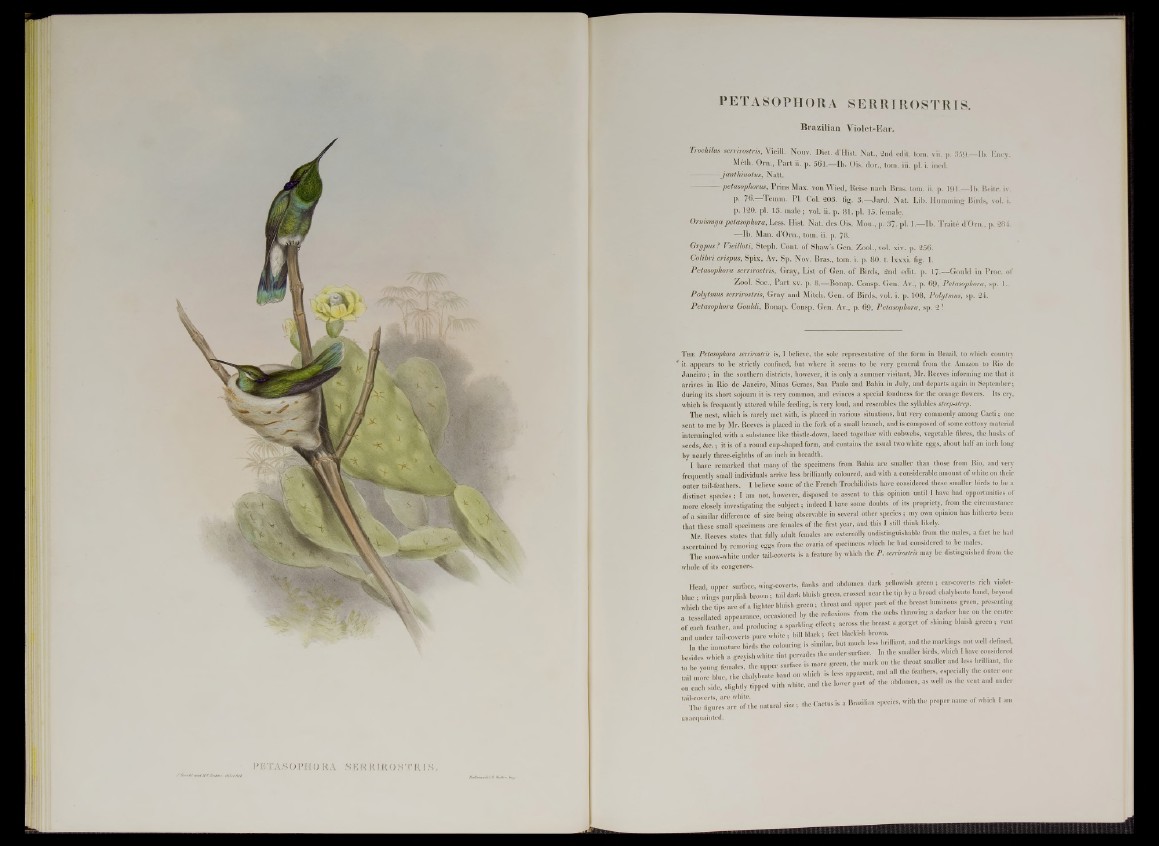
PETASOPHORA SERRIROSTRIS .
Brazilian Violet-Ear.
Trochitus serrirostris, Vieill. Nouv. Diet. d'Hist. N a t, 2nd edit. tom. vii. p. 359.—I . Ency.
Méth. Orn., P a rt ii. p. 561.—lb . Ois. dor., tom. iii. pi. i. ined.
— - janthinotus, Natt.
petasophorus, Prins Max. von Wied, Reise nach Bras. tom. ii. p. 191.—lb . Beitr. iv.
P* 76. Temm. PI. Col. 203. fig. 3.—Jard . Nat. Lib. Humming Birds, vol. i.
p. 120. pi. 13. male ; vol. ii. p. 81. pi. 15. female.
Ornismya petasophora, Less. Hist. Nat. des Ois. Mou., p. 3?. pl. 1.— Ib. Traité d’Orn., p. 284.
— Ib . Man. d’Orn., torn. ii. p. 78.
Grypus ? Vieilloti, Steph. Cont. of Shaw’s Gen. Zool., vol. xiv. p. 256.
Colibri crispus, Spix, Av. Sp. Nov. Bras., tom. i. p. 80. t. Ixxxi, fig. 1.
Petasophora serrirostris, Gray, List o f Gen. of Birds, 2nd edit. p. 17.—Gould in Proc. of
Zool. Soc., P a rt xv. p. 8.—Bonap. Consp. Gen. Av., p. 69, Petasophora, sp. ! ..
Polytmus serrirostris, Gray and Mitch. Gen. o f Birds, vol. i. p. 108, Polytmas, sp. 24.
Petasophora Gouldi, Bonap. Consp. Gen. Av., p. 69, Petasophora, sp. 2?
T he Petasophora serrirostris is, I believe, the sole representative of the form in Brazil, to which country
it. appears to be strictly confined, but where it seems to be very general from the Amazon to Rio de
Janeiro ; in the southern districts, however, it is only a summer visitant, Mr. Reeves informing me that it
arrives in Rio de Janeiro, Minas Geraes, San Paulo and Bahia in July, and departs again in September;
during its short sojourn it is very common, and evinces a special fondness for the orange flowers. Its cry,
which is frequently uttered while feeding, is very loud, and resembles the syllables strep-strep.
The nest, which is rarely met with, is placed in various situations, but very commonly among Cacti; one
sent to me by Mr. Reeves is placed in the fork of a small branch, and is composed of some cottony material
intermingled with a substance like thistle-down, laced together with cobwebs, vegetable fibres, the husks of
seeds, &c.; it is of a round cup-shaped form, and contains the usual two white eggs, about half an inch long
by nearly three-eighths of an inch in breadth.
I have remarked that many of the specimens from Bahia are smaller than those from Rio, and very
frequently small individuals arrive less brilliantly coloured, and with a considerable amount of white on their
outer tail-feathers. I believe some of the French Trochilidists have considered these smaller birds to be a
distinct species ; I am not, however, disposed to assent to this opinion until I have had opportunities of
.more closely investigating the subject; indeed I have some doubts of its propriety, from the circumstance
of a similar difference of size being observable in several other species ; my own opinion has hitherto been
that these small specimens are females of the first year, and this I still think likely.
Mr. Reeves states that fully adult females are externally undistinguishable from the males, a fact he had
ascertained by removing eggs from the ovaria of specimens which he had considered to be males.
The snow-white under tail-coverts is a feature by which the P. serrirostris may be distinguished from the
whole of its congeners.
Head upper surface, wing-coverts, flanks and abdomen dark yellowish green; ear-coverts rich violet-
blue ■ wings purplish brown; tail dark bluish green, crossed near the tip by a broad chalybeate band, beyond
which the tips are of a lighter bluish green I throat and upper part of the breast luminous green, presenting
a tessellated appearance, occasioned by the reflexions from the webs throwing a darker hue on the centre
of each feather, and producing a sparkling effect; across the breast a gorget of shining bluish green ; vent
and under tail-coverts pure white ; bill black; feet blackish brown
In the immature birds the colouring is similar, but much less brilliant, and he markings not well defined,
besides which a greyish white tint pervades the under surface. In the smaller birds which have considered
. 1 O females the upper surface is more green, the mark on the throat smaller and less brilliant, the
tail more blue, the chalybeate band on which is less apparent and all the feathers, especially the outer one
T e™ . side, ¡lightly tipped with white, and the lower part of the abdomen, as well as the vent and under
IliiEMMi „atnral size; the Cactus is a Brazilian species, with the proper name of which I am